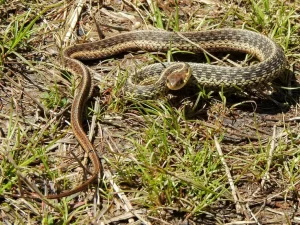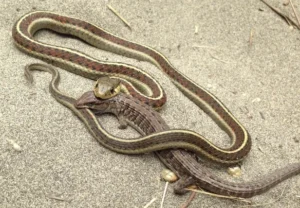Snakes are some of the most fascinating animals in the world. Even though they have no legs, they can move quickly and smoothly across all kinds of surfaces. One common question people ask is: how fast can snakes really move?
Some species of snakes, such as the black mamba can reach up to 12 mph when moving at full speed. Many other species such as rattlesnakes, are much slower, and reach 4 mph at full speed. Pythons are very slow, and move at less than 1 mph, even at full speed.
That said, snakes can only move at their full speed in short bursts that only last a few seconds. They are not adapted to maintain high speeds over long distances.
Also, the terrain on which a snake moves on can affect how fast it can go.
Snakes are generally faster on hard, flat ground (such as pavements), than bumpy or rocky ground.
How Fast Can Snakes Actually Move?
Snakes can actually move pretty fast, despite the fact that they don’t have legs. Here are a few examples:
1. Black Mamba
The black mamba is often called the fastest snake in the world. These snakes live in Africa and can reach speeds of 10 to 12 miles per hour.

That might not sound fast compared to a car, but it is very fast for a snake.
A black mamba can move faster than many people can run. They use this speed to catch prey and escape from danger.
2. Southern Black Racer
The Southern Black Race is one of the fastest snake species in North America.

It can move at speeds of up to 10 miles per hour, which is quite impressive for a snake. This speed allows it to quickly escape predators and chase down prey such as lizards, frogs, and small rodents.
Unlike many snakes that rely on stealth, the black racer often uses its speed as the main way to hunt, and also to escape predators.
3. Coachwhip Snake
The coachwhip snake lives in the southern United States and Mexico. These snakes are known for being quick and agile.

They can move at about 4 to 5 miles per hour. This speed helps them chase down lizards and insects across open ground.
4. Eastern Diamondback Rattlesnake
This is one of the largest venomous snakes in North America. It is not particularly fast, moving at only 2 to 3 miles per hour.

But, these snakes do not need to be fast. They rely on their powerful bite and venom to catch prey and defend themselves.
5. Common Garter Snake
Garter snakes are small and common in many parts of North America. They can move at about 1 to 2 miles per hour.

While not very fast, they make up for it with quick reflexes and the ability to change direction rapidly.
How Fast Other Snakes Can Move
| Snake Species | Top Speed |
|---|---|
| King Cobra (Ophiophagus hannah) | 5–6 mph (8–9.6 km/h) |
| Cottonmouth / Water Moccasin (Agkistrodon piscivorus) | 2–3 mph (3–5 km/h) |
| Rattlesnake (e.g., Crotalus atrox) | 2–4 mph (3–6 km/h) |
| Garter Snake (Thamnophis sirtalis) | 1–2 mph (1.6–3.2 km/h) |
| Ball Python (Python regius) | Less than 1 mph (~1.6 km/h) |
| Boa Constrictor (Boa constrictor) | Less than 1 mph (1.6 km/h) |
| Sidewinder (Crotalus cerastes) | 18 mph (29 km/h) in short bursts |
Why Speed Matters for Snakes
Speed is very important for snake survival. Snakes use speed for two main reasons: hunting and escaping danger.
When hunting, fast movement helps snakes catch prey before it can get away. Some snakes chase their prey across open ground. Others move quickly for just the final strike.
When escaping danger, speed can save a snake’s life. Many snakes prefer to run away rather than fight. A quick burst of speed can help them reach safety before a predator can catch them.
Speed also plays a role during mating season. Male snakes sometimes compete with females. The faster, more agile males may have better chances of mating success.
What Affects How Fast Snakes Can Move?
Several factors affect how fast a snake can move.
The Snake’s Body Size and Shape
How a snake’s body is built affects how it moves and how fast it can go.
Think of it like athletes – their bodies impact how well they perform.
For snakes, things like how long they are, how their muscles are arranged, and how heavy they are all matter for speed.
Generally, longer, muscular snakes can move faster. Their long bodies help them make more waves as they move on the ground. This pushes them forward efficiently, especially on flat ground.
On the other hand, heavier snakes like vipers and anacondas move slower. Their strong bodies are better for quick attacks and squeezing prey, not for moving fast.
They move in short, controlled movements and prefer to hide and wait for their prey to come close. Their size makes it hard to move quickly, especially on rough ground.
The Terrain the Snake Is Moving Through
The terrain a snake moves on can affect how fast it can go.
Unlike animals with legs, snakes use their bodies to grip the ground and move. So, the ground can either help them move faster or slow them down significantly.
On hard, flat ground, or surfaces like tile or pavement, snakes can move surprisingly fast. Their scales grip the surface, and their muscles help them move smoothly.
This is why snakes indoors can seem very fast – the floor makes it easy for them to move.
When the ground is bumpy, rocky, or has obstacles, snakes move more carefully.
Rocks and holes make them change their body position, which slows them down.
Some snakes are better at this and can lift parts of their body to get around things, but it’s still slower than on flat surfaces.
In forests or areas with lots of plants, snakes have to weave and squeeze through things. This slows them down greatly.
They also can’t see as well, so they have to move slower and be sneaky.
In short words, how fast a snake moves depends on the ground it’s on. A snake might be fast on pavement but slow in the sand.
The Temperature of the Surroundings
Temperature is very important for snakes to move. Snakes are cold-blooded animals. This means their body temperature matches the temperature around them.
When it is warm, snakes are more active and can move faster. When it is cold, they become slow and sluggish.
On very hot days, snakes sometimes actually slow down to avoid overheating. The best temperature for most snakes is somewhere in the middle; not too hot but also not too cold.
The Snakes Health and Nutrition
A healthy, well-fed snake will move better than a sick or hungry one. Snakes need good nutrition to build strong muscles.
They also need to be free of disease, and not have serious injuries to move at their best.
Older snakes tend to move more slowly than younger ones because their muscles are weaker and less flexible.
Why the Snake Is Moving
Snakes don’t just move fast for no reason. Like us humans, they have a purpose when they move.
When a snake is just relaxing in the sun or checking out its surroundings, it moves slowly and carefully. It feels safe and takes its time.
But, If a snake feels danger, like a person walking nearby or a bird flying overhead, it can suddenly move very fast. It’s trying to escape to safety.
This doesn’t last long, but it’s surprisingly quick!
Snakes also move fast to catch food. Some snakes hide and then strike, but others chase after their prey, like lizards or mice. They use quick bursts of speed to catch them.
Sometimes, a snake will stand its ground instead of running. If it feels trapped, it might coil up and get ready to strike. It’s not trying to be fast, it’s trying to be scary.
Snakes are smart creatures that don’t waste energy. If they don’t need to escape or hunt, they stay slow.
But when they need to, they can be surprisingly fast because they are motivated.
How Snakes Use Their Speed in the Wild
Snakes use speed in different ways depending on their hunting style and lifestyle.

Some snakes are active hunters. They search for prey and chase it down. These snakes need to be fast to catch animals that can run away. The coachwhip snake is a good example of an active hunter.
Other snakes are ambush predators. They wait quietly for prey to come close. Then they strike very quickly. These snakes may not need to move fast over long distances, but they need lightning-fast strikes.
Many snakes use speed mainly for escape. When threatened, they quickly slither away to safety. This is often their first choice when facing danger.
Conclusion
Understanding how snakes move helps us appreciate these remarkable animals. Their speed comes from millions of years of evolution and adaptation.
The next time you see a snake, you can think about the amazing processes behind every movement it makes.
Hi, my name is Ezra Mushala, i have been interested animals all my life. I am the main author and editor here at snakeinformer.com.

